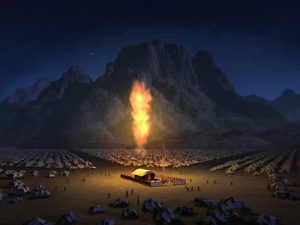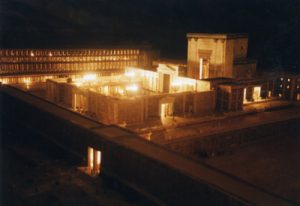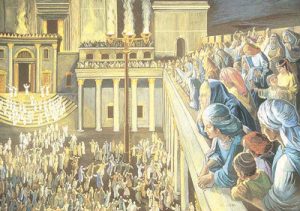Listen to Sermon Audio
John 8:12, 31-59; 9:1-7
In Mark Twain’s story, The Adventures of Tom Sawyer, Tom and Becky Thatcher join some classmates for a game of hide and seek in a cave. But when Tom and Becky wander off the marked path, they get lost. They stumble around in that dark dungeon for several days and slowly lose hope as their flickering candle finally goes out, leaving them in the darkness. They can’t see a thing; not even their hands held close to their faces. Tom begins to crawl about, but Becky is afraid she might fall in a hole. Finally Tom catches a glimpse of daylight through a crevice, makes his way back to get Becky, takes her by the hand and leads her out of the darkness of the cave and into the bright light of the day. Hurray!
Reminds us of that famous proclamation of the prophet from Jerusalem Isaiah, “The people who wander in darkness will see,” what, not just a glimmer of light but a “great light” (9:2 NLT). If even the smallest glimmer of light can be a marvelous source of hope, guidance and direction as it was for Tom and Becky, just imagine what a bright light can do for anyone wandering in darkness, especially spiritual darkness.
750 years after Isaiah, along comes the prophet from Nazareth to boldly proclaim: “I am the light of the world. He who follows Me will not walk in the darkness but have the light of life” (John 8:12).
Let’s consider the context of this great ‘I am’ saying.
 John 7:2 tells us the setting for this occasion was the Festival of the Tabernacles, at which the Jews remembered and celebrated wandering in the wilderness for 40 years after their escape from Egypt. You might wonder why they celebrated that event. And the answer is that while they wandered, God went with them in the form of the pillar of cloud by day and pillar of fire by night.
John 7:2 tells us the setting for this occasion was the Festival of the Tabernacles, at which the Jews remembered and celebrated wandering in the wilderness for 40 years after their escape from Egypt. You might wonder why they celebrated that event. And the answer is that while they wandered, God went with them in the form of the pillar of cloud by day and pillar of fire by night.
The Lord went ahead of them. He guided them during the day with a pillar of cloud, and he provided light at night with a pillar of fire. This allowed them to travel by day or by night. And the Lord did not remove the pillar of cloud or pillar of fire from its place in front of the people. (Exodus 13:21-22)
 To commemorate that episode in their history, on the evening of the first day of that Festival of Tabernacles there was a ceremony called the Illumination of the Temple that took place in the Court of the Women. Early Jewish writings (Sukkah 52, 53) tell us that at dusk the priests would descend from the Court of the Israelites down into the Court of Women. In that Court of the Women stood four huge 75 foot high candelabra, each with four golden bowls at their tops. Wicks made from the worn-out undergarments of the priests were placed in each bowl and lit. One source informs us that there was no courtyard in Jerusalem that was not lit up with the light which came from these candelabras. Then, the rest of the night, the orchestra of the Levites would take their place on the 15 steps down from Court of the Israelites to the Court of the Women and play Psalms 120-134 on their harps, lyres, cymbals and trumpets, while priests would sing and dance before the Lord.
To commemorate that episode in their history, on the evening of the first day of that Festival of Tabernacles there was a ceremony called the Illumination of the Temple that took place in the Court of the Women. Early Jewish writings (Sukkah 52, 53) tell us that at dusk the priests would descend from the Court of the Israelites down into the Court of Women. In that Court of the Women stood four huge 75 foot high candelabra, each with four golden bowls at their tops. Wicks made from the worn-out undergarments of the priests were placed in each bowl and lit. One source informs us that there was no courtyard in Jerusalem that was not lit up with the light which came from these candelabras. Then, the rest of the night, the orchestra of the Levites would take their place on the 15 steps down from Court of the Israelites to the Court of the Women and play Psalms 120-134 on their harps, lyres, cymbals and trumpets, while priests would sing and dance before the Lord.
 Can you see it? At some point during this celebration of the presence of God’s light, Jesus makes His way to center court and claims, “I am the light of the world.” In other words, He is saying, “We are here tonight to celebrate that time in our nation’s history when we were led about through the wilderness by the Father’s presence in a pillar of cloud by day and pillar of fire by night. I am that pillar of fire of God’s presence. As our people followed that pillar of fire through the darkness that eventually led them to this Promised Land, ‘he who follows Me shall not walk in darkness but have the light of life.’”
Can you see it? At some point during this celebration of the presence of God’s light, Jesus makes His way to center court and claims, “I am the light of the world.” In other words, He is saying, “We are here tonight to celebrate that time in our nation’s history when we were led about through the wilderness by the Father’s presence in a pillar of cloud by day and pillar of fire by night. I am that pillar of fire of God’s presence. As our people followed that pillar of fire through the darkness that eventually led them to this Promised Land, ‘he who follows Me shall not walk in darkness but have the light of life.’”
Three things bubble to the surface for this preacher.
The first and most obvious is that Jesus is claiming to be God. If that wasn’t clear in His ‘light of the world’ proclamation, He left no doubt about it when He concludes His remarks by saying, “Before Abraham was born, I, I am.” In Exodus 3, you recall that God spoke to Moses from a burning bush informing Moses that he was being chosen to lead the Israelites out of Egypt. Moses doesn’t really want the job.
But Moses protested, “If I go to the people of Israel and tell them, ‘The God of your ancestors has sent me to you,’ they will ask me, ‘What is his name?’ Then what should I tell them?” God replied to Moses, “I AM WHO I AM. Say this to the people of Israel: I AM has sent me to you. (Exodus 3:13-14)
So you see, Jesus in this instance is claiming to be the same who spoke to Moses.
Gary Burge in his fine commentary on John writes:
This long chapter sustains numerous arguments between Jesus and His opponents in the city of Jerusalem. Charges and counter-charges tumble over one another until the tension between Jesus and the theologians of Jerusalem reaches a crescendo at the end of the chapter. His opponents hurl a devastating criticism at Him, “You are a Samaritan and demon-possessed” (8:48), while Jesus offers the most Christological self-description yet in the gospel, “Before Abraham was born, I am (8:59).” The battleground is truth and identity with God. Is Jesus fraudulent or are His accusers? 1
His claim challenges us like it did the people who first heard it to line up on one side or the other of the issue. Either Jesus was an egomaniac who was suffering from delusions of grandeur or He was telling the truth. His claim has a way of separating the men from the boys. Was He a lunatic or was He God?
On January 9th, 2007, Joshua Bell sold out Boston’s Symphony Hall at $100 a seat. Bell plays a Stradivarius violin handcrafted by the master himself in 1713 for which Bell paid $4 million. He is recognized as one of the best musicians in the world.
Three days later, he entered a metro station in Washington, D.C. wearing casual clothing and a ball cap. He opened his case and played his violin for 45 minutes. Only seven people of the thousands that passed by stopped to listen; 20 people threw a total of $32.17 in his open violin case as they passed by. Only one person recognized him for who he was.
The same dynamic occurred during the Illumination of the Temple and it continues to this day. How many people have a close encounter with Christ and yet not recognize Him for who He is; the God of the universe.
I want to believe with all my heart that those gathered here have chosen to embrace what Jesus claimed: God wrapped in human flesh.
Secondly, He is inviting people to ‘follow’ Him. What does that mean ‘to follow Him?’
I always try to interpret the Bible from its immediate context and in this case Jesus as a rabbi is inviting his listeners to follow Him because He is God, rather than the Pharisees who represent the Jewish Religious Laws. And so I believe the emphasis should be on the word ‘Me’ rather than ‘follow.’ It’s like He is saying, if you follow those guys, and their endless set of laws, rules and regulations . . . that’s darkness! On the other hand, if you follow Me, you’ll be walking in the light.
After all, He is God. God’s first act of creation was “Let there be light.” Psalm 27:1 says, “God is our light and salvation.” Psalm 119: “His word is a lamp unto our feet and a light unto our path” (Ps 119:105). In the prologue to this gospel, John declares, (Jn 1:5) “The light shines in the darkness and the darkness can never extinguish it.” We just sang, “He wraps Himself in light and darkness tries to hide.” In other words, if you follow Jesus/God you will be in the light because God is light and in Him is no darkness at all.
So at this point, Jesus is just encouraging people to follow Him. He doesn’t flesh out what that means or implies. He is simply asking folks to consider following Him.
To be sure, Bible commentators like William Barclay, for example, dig into the word ‘follow’ and its various shades of meaning in an attempt to let potential followers know what they are in for. And to be sure, I believe there’s a time and place for that, but at this point in John’s gospel he is just working on his purpose (John 20:30-31):
The disciples saw Jesus do many other miraculous signs in addition to the ones recorded in this book. But these are written so that you may continue to believe that Jesus is the Messiah, the Son of God, and that by believing in Him you will have life by the power of His name.
Third, those who follow Jesus will walk in the ‘light of life.’
‘Life’ is the keyword of John’s gospel. Matthew, Mark, and Luke use it 18 times combined. John doubles that number employing ‘life’ 36 times.
So what does it mean to walk in the light of life? And again in keeping with the context of John’s gospel, I refer us back to the section that immediately precedes this ‘I am’ saying. There was a woman who was caught in the act of committing adultery. These same Pharisees dragged this woman before Jesus and in an attempt to trap Him into contradicting their religious Laws stated that the law of Moses demanded she be stoned to death and asked Jesus if He agreed. When Jesus ingeniously replied, ‘He who is without sin cast the first stone,’ as many commentators have stated, you could hear the thud of the stones as they dropped one by one from their hands until there was no one left standing there except Jesus and the woman.
“‘Woman, where are your accusers? Didn’t even one of them condemn you?’
‘No Lord,’ she said.
‘And Jesus said, neither do I; go and sin no more’” (John 8:10-11).
To walk in the light of ‘life’ then is first of all to be forgiven of all of our sins, and secondly to begin to live a life that shows appreciation for the One who forgave.
Jesus said: “He who follows me will not walk in darkness, but will have the light of life.” Just as the flower can never blossom when it never sees the sunlight, so our lives can never flower with the grace and beauty they ought to have until they are irradiated with the light of the presence of Jesus.
I close with a 21st century account of the ‘light of life.’ Twenty-three-year-old Rusty Welborn from Point Pleasant, West Virginia was on death row in a South Carolina prison for the murder of a Myrtle Beach woman. Bob McAlister, deputy chief of staff to South Carolina’s governor, had become a Christian and decided to minister to the state’s inmates, especially those spending their last days on death row.
Bob’s first look at Rusty revealed a pitiful sight. He was lying on the floor of his cell, the only signs of life were the roaches who scurried over everything, including Rusty himself. He stared blankly at Bob as he began to talk, but did not respond. During visit after visit, Bob tried to tell him about the love/forgiveness of Jesus and the opportunity, even on death row, to start a new life in Christ. Little by little, he opened up, until one day he began to weep, a pitiful man with murder and darkness behind him, he gave his heart to Christ.
When Bob returned to Rusty’s cell a week later, he found a new man. The cell was clean and so was Rusty. He had renewed energy and a positive outlook on life. McAlister continued to visit over the next 5 years and they became close friends. In fact, McAlister said that Rusty grew into the son he never had, and as for Rusty, he had taken to calling McAlister ‘Pap.’
Bob learned that Rusty grew up never knowing real love from anyone and he never ceased to be surprised that someone could love someone like him. In time, Rusty became burdened by the pain he had caused the family of his victim. About the same time a most significant thing happened: the brother of the woman Rusty had murdered became a Christian. God had been dealing with him about his need to forgive his sister’s killer. Bob was present when the two men met and tearfully embraced. Rusty’s senseless crime ten years earlier had erected a seemingly impregnable barrier between himself and the brother. But the light of Christ’s love and forgiveness shattered that barrier!
On his final day, Rusty asked McAlister to read to him from the Bible. After an hour or so of listening, Rusty sat up on the side of his cot and said, ‘You know, the only thing I ever wanted as a kid was a home, Pap. Now I’m going to get one.’ A short time later, Rusty Welborn was executed for murder.
For the first 24 years of his life, Rusty Welborn had walked in darkness, until Bob McAlister invited him to believe in the Light of the world. And when he did, he experienced the light of LIFE. 2
1 Burge. Gary. The NIV Application Commentary. [Grand Rapids, Zondervan © 2000]
page 264).
2 Young Ed. Bad Beginnings to Happy Endings. [Nashville: Thomas Nelson Publ.,
1994], pages 3-5.
